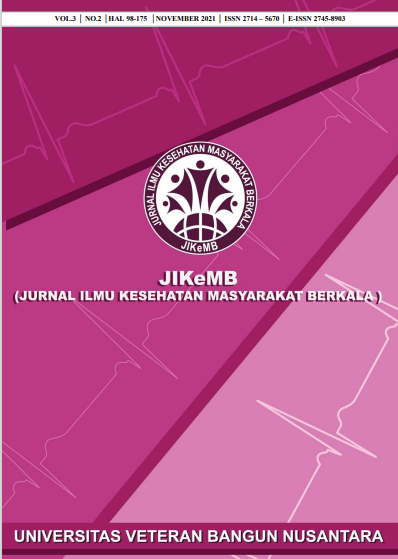Factors Associated with Prevention of Hypertension in Adolescents
DOI:
https://doi.org/10.32585/jikemb.v3i2.1937Keywords:
Hypertension Prevention, AdolescentsAbstract
Currently, people with hypertension are not only experienced by someone who is elderly, but teenagers in particular have been diagnosed with hypertension. Data from the Jambi City Health Office in 2020 shows that the Paal Merah II Health Center is a health center that has the highest prevalence of hypertension, which is 7.54%. The purpose of the study was to determine the factors associated with the prevention of hypertension in adolescents. The study used a cross sectional approach. The study was conducted in the working area of the Paal Merah II Public Health Center, Jambi City, from June to July 2021. The research sample was teenagers aged 15-19 years as many as 59 people. The sampling technique used was purposive sampling technique. Data were analyzed by univariate and bivariate using chi square test. A total of 49.2% of respondents had poor hypertension prevention behavior, 44.1% of respondents had poor knowledge, 45.8% of respondents had poor attitudes, 47.5% of respondents had poor self-efficacy, 40.7% of respondents had poor self-efficacy. social media is not good and 47.5% of respondents have less good peers. The results of the bivariate analysis showed that there was a relationship between knowledge (p-value = 0.013), attitudes (p-value = 0.027), self-efficacy (p-value = 0.000), social media (p-value = 0.050) and peers (p-value = 0.050). value=0.013) with hypertension prevention in the work area of Paal Merah II Health Center. It is expected that adolescents can prevent hypertension well such as doing physical activity (exercise) regularly 2-3 times a week for 30 minutes, not smoking, not consuming fast food and being able to control emotions when there is a problem so as to reduce the risk of hypertension.
Downloads
References
Alhidayati, Nyrhapipa, & Putri, R. (2017). Relationship of Adolescents Behavior To Consumption Of Soft Drink in SMPN 5 Pekanbaru Year 2016. Photon: Jurnal Sains Dan Kesehatan, 7(2), 44–49.
Anggai, A. I. (2015). Hubungan Antara Efikasi Diri Dengan Perilaku Berisiko Terhadap Kesehatan Pada Remaja. Universitas Muhammadiyah Surakarta.
Dinkes Kota Jambi. (2021). Profil Kesehatan Kota Jambi Tahun 2020. Jambi: Dinas Kesehatan Kota Jambi.
Fitrianingsih, Siswanto, Y., & Tarmali, A. (2015). Beberapa Faktor yang Berhubungan dengan Kejadian Hipertensi pada Remaja di SMAN 1 Ungaran Kabupaten Semarang. Jurnal Gizi Dan Kesehatan, VIII(7), 33.
Hariawan, H., Tidore, M., & Rahakbau, G. Z. (2020). Perilaku Pencegahan Penyakit Tidak Menular Pada Remaja Ambon. Integrated Nursing Journal, 2(1), 15–21.
Kemenkes RI. (2013). Panduan Peringatan Hari Kesehatan Sedunia :Waspada Hipertensi Kendalikan Tekanan Darah. Jakarta: Kementerian Kesehatan Republik Indonesia.
Kemenkes RI. (2014). Infodatin Hipertensi. Jakarta: Kementerian Kesehatan Republik Indonesia.
Kemenkes RI. (2018a). Laporan Riset Kesehatan Dasar Provinsi Jambi Tahun 2018. Jakarta: Kementerian Kesehatan Republik Indonesia.
Kemenkes RI. (2018b). Laporan Riset Kesehatan Dasar Tahun 2018. Jakarta: Kementerian Kesehatan Republik Indonesia.
Kemenkes RI. (2020). Strategi Pencegahan dan Pengendalian PTM di Indonesia. Jakarta: Kementerian Kesehatan Republik Indonesia.
Lutfiana, A. (2012). Asupan Tinggi Natrium dan Berat Badan Lahir Sebagai Faktor Risiko Kejadian Hipertensi Obesitas pada Remaja Awal. Universitas Diponogoro.
Notoatmodjo, S. (2012). Kesehatan Masyarakat Ilmu Dan Seni. Jakarta: Rineka Cipta.
Nurhidayati, S. (2014). Faktor Risiko penyakit Kardiovaskuler Pada Remaja di Ponorogo. DK, 2.
Palmer, A., & Williams, B. (2005). Simple Guides Tekanan Darah Tinggi. Jakarta: EGC.
Peach, H., Gaultney, J. F., & Reeve, C. L. (2015). Sleep Characteristics, Body Mass Index, and Risk for Hypertension in Young Adolescents. J Youth Adolescence, XLIV(280).
Pontoh, M. M., Rondonuwu, R., & Tandipajung, T. (2016). Hubungan Pengetahuan Masyarakat dengan Upaya Pencegahan Hipertensi di Puskesmas Amurang Timur Kabupaten Minahasa Selatan. E-Jurnal Sariputra, 3(2), 82–88.
Puskesmas Paal Merah II. (2021). Profil Puskesmas Paal Merah II Tahun 2020. Jambi: Puskesmas Paal Merah II.
Tondang, M. L., & Nasution, S. Z. (2012). engetahauan dan Sikap Remaja tentang Perilaku Hidup Sehat di Panti Asuhan Evangeline Booth dan Asrama Madani. Jurnal Kesehatan Masyarakat, 5(2), 1–6.
Uryani, V. (2016). Hubungan Pengetahuan dan Sikap dengan Upaya Pencegahan Hipertensi di Balai Pengobatan Umum Puskesmas Andalas Padang. Universitas Andalas.
Utari, O. R. A., Kusumawati, A., & Husodo, B. T. (2020). Pengaruh Media Sosial terhadap Perilaku Merokok Siswa SMP Usia 12-14 Tahun di Kota Semarang. Jurnal Kesehatan Masyarakat, 8(2), 298–303.
Wahyudi, D. T. (2019). Sikap dan Perceived Threat Terhadap Perilaku Pencegahan Hipertensi. Journal Of Borneo Holistic Health, 2(1), 118–124.
WHO. (2013). A Global Brief on Hypertension: Silent Killer, Global PublicHealth Crisis. Switzerland: WHO.
Yusrizal, M., Indarto, D., & Akhyar, M. (2016). Risk of Hypertension in Adolescents with Over Nutritional Status in Pangkalpinang, Indonesia. Journal of Epidemiology and Public Health, 1(1), 32–33.
Downloads
Published
How to Cite
Issue
Section
License
An author who publishes in the Jurnal Ilmu Kesehatan Masyarakat Berkala (JIKeMB) agrees to the following terms:
- Author retains the copyright and grants the journal the right of first publication of the work simultaneously licensed under the Creative Commons Attribution-ShareAlike 4.0 License that allows others to share the work with an acknowledgement of the work's authorship and initial publication in this journal
- Author is able to enter into separate, additional contractual arrangements for the non-exclusive distribution of the journal's published version of the work (e.g., post it to an institutional repository or publish it in a book) with the acknowledgement of its initial publication in this journal.
- Author is permitted and encouraged to post his/her work online (e.g., in institutional repositories or on their website) prior to and during the submission process, as it can lead to productive exchanges, as well as earlier and greater citation of the published work (See The Effect of Open Access).
Read more about the Creative Commons Attribution-ShareAlike 4.0 Licence here: https://creativecommons.org/licenses/by-sa/4.0/.










